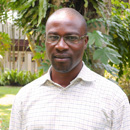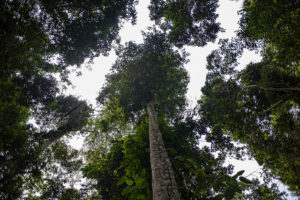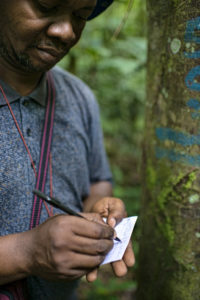 One of the successful academic partnerships under the CGIAR Research Program on Forests, Trees and Agroforestry (FTA) is the collaboration with the University of Kisangani in the Democratic Republic of Congo (DRC). As recent as 2005, the DRC counted just six people with an educational qualification higher than a Bachelor’s degree in forestry and related disciplines who were actively involved in research. We asked Christian Amani, a former student from DRC who now works as a scientific adviser for the Center for International Forestry Research (CIFOR), to tell us about the partnership from his perspective.
One of the successful academic partnerships under the CGIAR Research Program on Forests, Trees and Agroforestry (FTA) is the collaboration with the University of Kisangani in the Democratic Republic of Congo (DRC). As recent as 2005, the DRC counted just six people with an educational qualification higher than a Bachelor’s degree in forestry and related disciplines who were actively involved in research. We asked Christian Amani, a former student from DRC who now works as a scientific adviser for the Center for International Forestry Research (CIFOR), to tell us about the partnership from his perspective.
How did the collaboration between Center for International Forestry Research (CIFOR) and the University of Kisangani come about?
The collaboration between CIFOR and the University of Kisangani dates back to the years 2006-2007. The momentum for this collaboration came from a survey conducted by CIFOR and its partners including the UN Food and Agricultural Organization (FAO). This survey aimed to assess the national forestry skills in a country that is home to the second largest rainforest in the world with some 86 million hectares: DR Congo.
Of course, that survey revealed the country urgently needed to invest in capacity building in order to achieve sustainable management of its forests. This is how the capacity development by CIFOR started.
The University of Kisangani was selected to harbour these programs based on its experience in training scientists in the field of Biology and its strategic location within the Central Congo Basin.

How has the partnership evolved since 2011 when FTA started?
Since the beginning of the partnership, nearly 160 Congolese students have successfully attended the capacity development program, training people at both Master’s and PhD levels. Candidates have to go through a selection process, which is launched nationwide in the media and other available communication channels.
The very first project (REAFOR) from 2007 to 2010 mainly focused on agricultural and forestry researchers and trained 35 MSc students and 12 PhD students. This was then perceived as a historical achievement in my country. Under the second project (REFORCO) from 2009 to 2013, focused on forestry research, 39 students received a MSc degree and 18 were awarded PhDs.
The ongoing Forests and Climate Change in Congo (FCCC) started in 2012, funded by the EU’s Global Climate Change Alliance, and will end in December 2016. Overall 44 MSc and 11 PhD students were enrolled in the program.
Also read: A new generation of forest managers in the Democratic Republic of Congo
The bulk of the trained students is recruited by Congolese universities and other national institutions that focus on scientific research. They did this in order to pass on the knowledge they’ve acquired to the next generation of forestry students.
The ongoing FCCC project is a bit different from the previous two capacity development programs because its activities go beyond the central Congo Basin and the University of Kisangani. It has a second component with activities in the Virunga National Park’s landscape.
Many partners, including the World Agroforestry Centre (ICRAF), the Congolese Institute for Nature Conservation (ICCN), CIRAD, the Worldwide Fund for Nature (WWF) and the Virunga Foundation, work together in order to help restore the highly degraded lands within the Park and plant trees outside the Park. The goal is to mitigate the pressure on the Park in this densely populated area where access to energy is a major issue.

What is the most important achievement of the partnership?
Thanks to the project, the number of Congolese scientists has increased significantly. Many of the candidates are still very young which makes me very hopeful for the future. Training programs are of high quality and meet international standards given that many international scientists are involved in teaching and supervising research.
For the first time in the academic history of the country, we are able to get highly qualified scientists with a much broader and updated view of the forestry sector, which was previously considered functioning as a silo. These newly trained scientists bring to the country a holistic approach, combining both biophysical research and social sciences, thanks to the two major fields of studies: “Man and the Forest” and “Forest and the Environment”.
The current FCCC project helped bring major improvements to the university program by also reforming the curricula.
Firstly, the university introduced an approach called teaching binome systems, which means that, whenever possible, two teachers, an international expert and a Congolese counterpart, were involved in a given course in order to reinforce collaboration.
Secondly, the students received additional English classes and annual Science Week sessions to complement the formal courses. The teaching staff at the University of Kisangani are offered opportunities to attend international conferences and training courses worldwide.
And, to help reach sustainability, the university infrastructure was upgraded by rehabilitating existing and building new classrooms, by securing electricity supply, and improving the ICT systems including the local electronic library.

What is your own story in this?
I was one of the people who were granted a PhD scholarship under the very first CIFOR project in DR Congo. The grant allowed me to conduct my PhD research in some forests located in the central Congo Basin where I tried to understand the impact of edaphic heterogeneity on vegetation features in those ecosystems.
At the end my PhD program in Brussels, Belgium, I was fortunate to maintain contacts with some of the CIFOR scientists and was therefore invited to teach in the MSc courses during the second CIFOR project REFORCO at the University of Kisangani.
In 2013, I applied for a scientific adviser position at CIFOR under the FCCC project and got the job. Apart from teaching at the ongoing Master’s program and co-supervising MSc and PhD students at the University of Kisangani, my position allows me to interact with research partners working in the Virunga National Park’s landscape, which again inspires my teaching at the university.











